I am having trouble solving this Op-Amp problem. I'm looking for Vo, and am confused as what to do with the 9V supply and the 2k and 6k resistors. Would the 9V be split between these two resistors? Also, when doing KCL for the V- value, should I include the current from Vo over the 4k resistor in the KCL equation? I feel like I'm right on the cusp of understanding with this one...
- 1,542
- 12
- 18
- 71
- 4
-
What do you mean by "split"? If we assume the wires to be ideal, then any points connected by wires will have the same voltage. – The Photon Apr 15 '20 at 23:34
-
I mean the voltage drop across the 2k and 6k resistors. The 9V supply is divided between these two resistors. – lm1998 Apr 15 '20 at 23:36
-
2I'd say "9 V is applied to both resistors". There's no "dividing" going on here. One resistor sees the whole 9 V and so does the other one. (Not, for example 6 V going to one resistor and 3 to the other one). Now if you look at the 6k and 4k resistors, they form what we usually call a *voltage divider*. – The Photon Apr 15 '20 at 23:41
-
The 6k and 4k are a voltage divider? I thought by the KCL equation, the current of that 4k resistor would be defined as V(-)/4k – lm1998 Apr 15 '20 at 23:44
-
The bottom 4k resistor (If you provided designators for the components in your schematic, this wouldn't be ambiguous). – The Photon Apr 15 '20 at 23:50
-
Added. Sorry I'm still not quite getting it *And I said V(-) when I meant V(+). Oops* – lm1998 Apr 15 '20 at 23:55
-
imagine a 9 V battery ... now attach a light bulb across the two battery terminals so that the light bulb is lit .... what is the voltage across the light bulb? .... now add a second light bulb across the two battery terminals in parallel with the first light bulb ... what is the voltage across each of the light bulbs? – jsotola Apr 16 '20 at 00:05
-
Yes, the current through the lower 4k resistor is \$V_+/4\ k\Omega\$. But how are you going to calculate what \$V_+\$ is? You're going to use the resistor divider formula with the 9 V source and the 6k and 4k resistors. – The Photon Apr 16 '20 at 00:11
-
Did you try solving by applying superposition theorem? – G-aura-V Apr 16 '20 at 00:49
-
@Giga-Byte I haven't. Just KCL for V(+) and V(-), then setting those expressions equal to each other. – lm1998 Apr 16 '20 at 01:22
3 Answers
Just re-draw the schematic, slightly:

simulate this circuit – Schematic created using CircuitLab
(Note that your confusion about "Would the 9V be split between these two resistors?" completely dissolves away by re-drawing the schematic in this modest way. And also note that I didn't actually change any meaning by doing so.)
Assuming the \$V_+\$ input neither draws nor sinks any current, you know easily how to compute \$V_+\$. It's a dead-trivial resistor-divider calculation.
Similarly, you know that the opamp (assuming it has access to the needed voltage rails) output will be adjusted such that \$V_-=V_+\$.
So it should be dead-easy to compute \$I_3\$ and \$I_4\$ (their signs not necessarily the same) and therefore \$I_5\$. Since you know the value of \$V_-\$ and the voltage drop across \$R_5\$, it's very easy to work out what \$V_\text{O}\$ must be.
- 77,059
- 6
- 73
- 185
-
-
I guess what confuses me most is why the calc for V(+) is a voltage divider. Is it because we're only interested in what the voltage is from ground? – lm1998 Apr 16 '20 at 16:30
-
@lm1998 I actually thought that would be the easier part for you. Take a close look at your schematic (or my version of it.) You can reasonably assume that the V+ input to the opamp doesn't sink or source current (it's "high impedance" and doesn't "load" the two resistors at their joined node.) Therefore, all you have is two resistors sitting between a voltage and ground. This is exactly a resistor divider and it's taught in chapter 1 of any book on beginning electronics. What other voltage would you imagine there? – jonk Apr 16 '20 at 18:01
-
@lm1998 Also, keep in mind that your opamp doesn't have a reference to ground unless you provide one. It has access to the "most positive" and "most negative" voltages you give it. It doesn't actually mysteriously know anything about where the circuit "ground" is at. Besides, that's a fictional idea we use to aid communication. You could just as well call the negative voltage "ground" and then show the positive voltage to the opamp as the difference value. Voltages are all relative -- they require two points, not one point. When "ground" is selected it helps ease communication. That's all. – jonk Apr 16 '20 at 18:04
I'm looking for Vo, and am confused as what to do with the 9V supply and the 2k and 6k resistors. Would the 9V be split between these two resistors?
Both are being fed 9V since they're sharing the same node. The current is what's being split.
Also, when doing KCL for the V- value, should I include the current from Vo over the 4k resistor in the KCL equation?
Yes, it will be handy for solving Vo.
If you look at the (+) input, It's a voltage divider with the 9V supply:
 A useful thing in this case would be the virtual short principle. It can be concluded that the (+) input is at the same voltage as the (-) input.
A useful thing in this case would be the virtual short principle. It can be concluded that the (+) input is at the same voltage as the (-) input.
A KCL at (-) would then solve for Vo. Current entering = Current leaving.
$$ \frac{3V-3.6V}{5kΩ} + \frac{9V-3.6V}{2kΩ} = \frac{3.6V-V_o}{4kΩ}$$

- 624
- 7
- 23
Looks like homework. Hint: the (+) input will be the same as the (-) input based on the op-amp's assumed-infinite gain. Now what's the 9V doing to the (+) side?
- 49,832
- 2
- 47
- 138
-
So by that assumption, that 9V would not be split. The KCL for the V+ would be (V+-9)/6k then? – lm1998 Apr 15 '20 at 22:50
-
The pair of resistors connected to V+ are a voltage divider. Solve for V+, then you know V-. Then use KCL to solve what V- is. – hacktastical Apr 15 '20 at 22:58
-
Okay, that's what I was originally thinking. And, just to make sure I'm not completely losing my mind, the pair of resistors are in parallel, correct? – lm1998 Apr 15 '20 at 23:32
-
